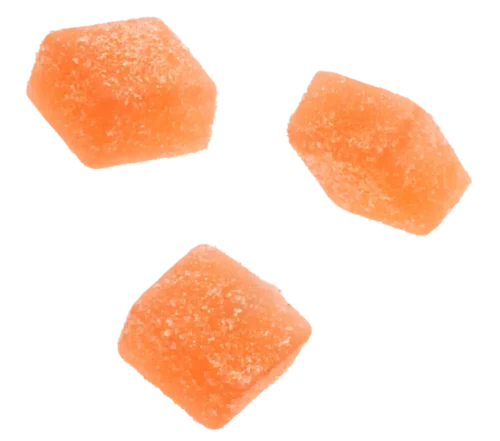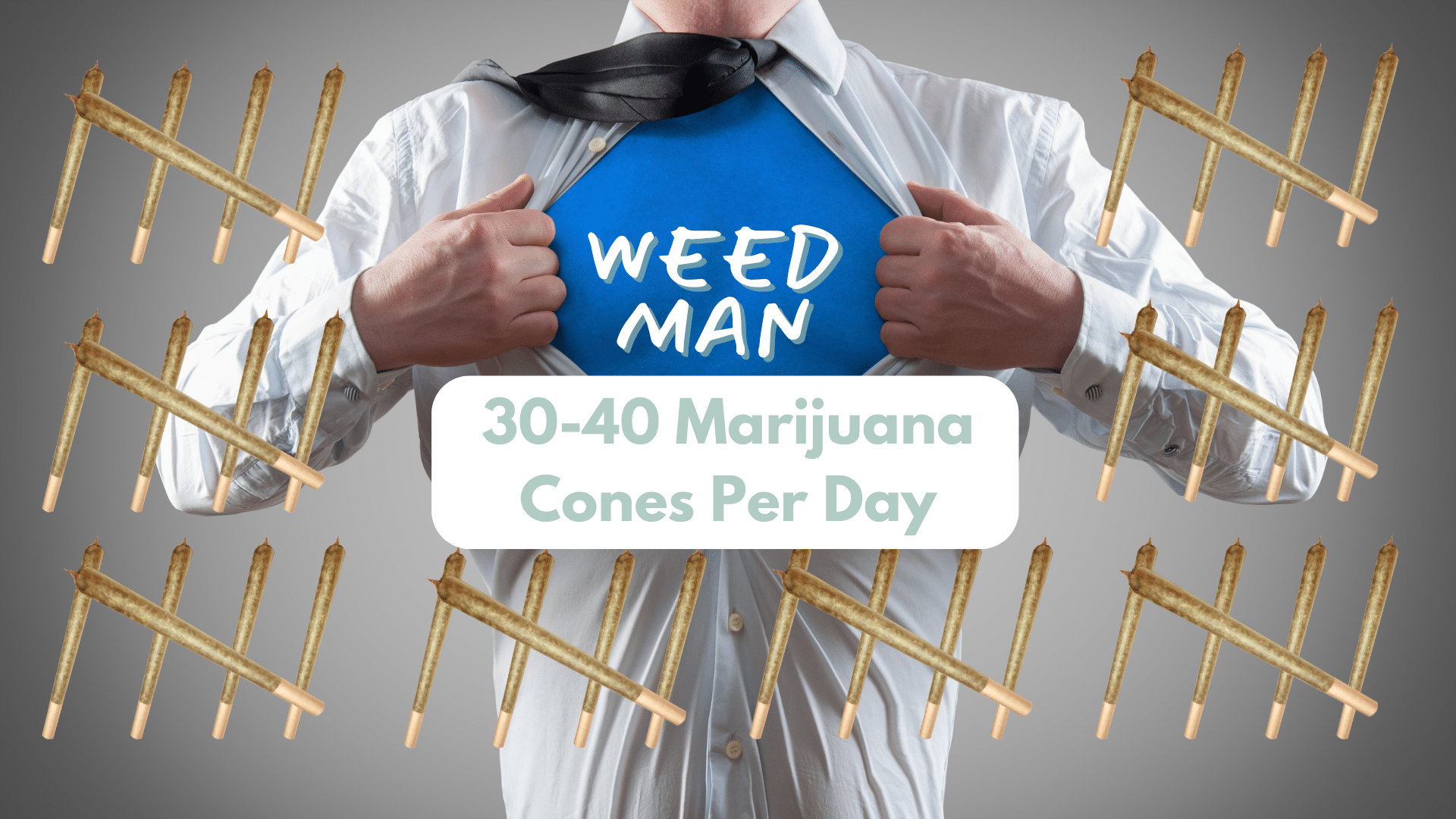Cannabinoid Hyperemesis Syndrome (CHS): Latest Facts, Shocking Truth
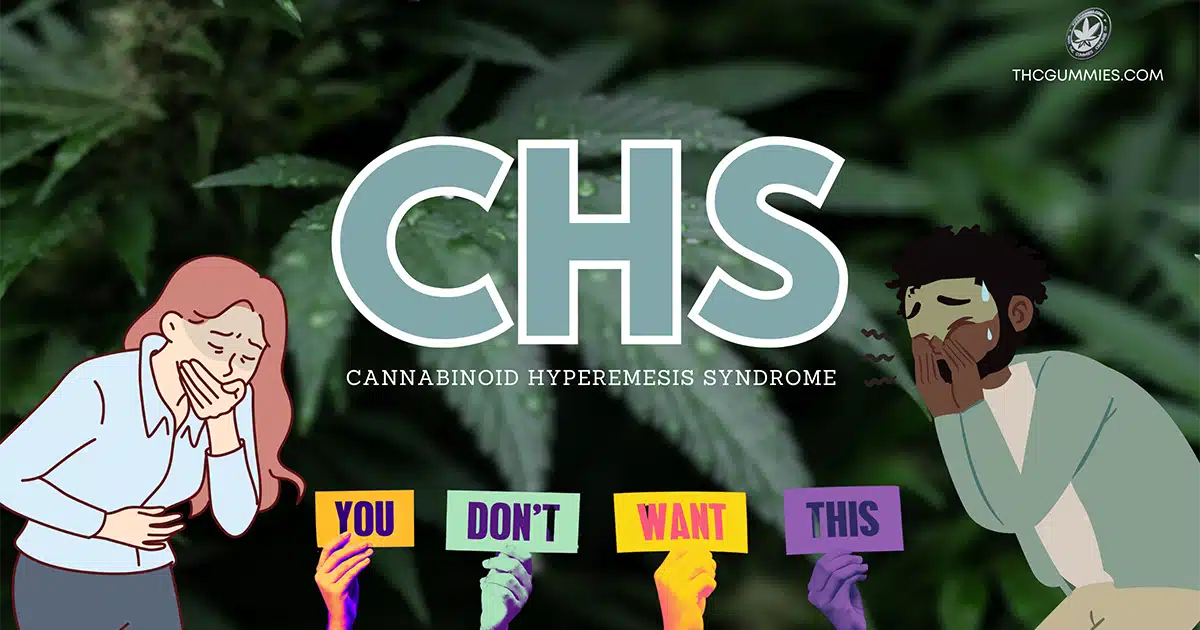

Christopher Visser
Multi-Cannabis Business Owner
Christopher Visser, the Founder and CEO of Cannabidiol Life and THCGummies.com, is a distinguished figure in the CBD industry, recognized for his pioneering contributions since 2016. With over 120 published articles, Christopher has become a reputable cannabis researcher, writer, and author. He's built two prosperous cannabis ventures that collectively generated millions in annual sales. His in-depth analysis of numerous cannabis studies, collaboration with medical professionals, and personal engagement with thousands of customers underline his expertise and commitment to advancing cannabis understanding daily.
-
 Written By:
Christopher Visser
Written By:
Christopher Visser
- Published:
- Updated: February 8, 2024
- Too Quiet, Light Up The Convo!
Cannabinoid Hyperemesis Syndrome (CHS), a condition that will force you to quit cannabis forever or suffer from extreme nausea and VOLATILE VOMIT for the rest of your life.
Table of Contents
The Quickest answer.
Cannabinoid Hyperemesis Syndrome (CHS) is a rare condition that is part-time debilitating due to on-and-off cycles of severe nausea, volatile vomiting, and abdominal pain. Following these symptoms, its common to experience severe constipation and weight loss; caused by dehydration, the main side effect from the initial symptom (nausea caused excessive and uncontrollable vomiting).
Science in 2024 leans towards chronic/daily consumption of THC, spanning over the the course of a decade or more, but unsure. The latest? Your genetics seem to now be involved in the mix.
CHS is categorized as a categorized as a functional gastroduodenal disorder.
Outside from Schizophrenia and Parkinson’s, Cannabinoid Hyperemesis Syndrome (CHS) is ranked 3rd worst on the all-time long-term use adverse effects of THC.

What Does Hyperemesis Mean, & How To Pronounce It
In case you were wondering how this condition got its name, it’s actually fairly basic. Check it out:
- Cannabinoid: THC seems to be the main cause of CHS, and THC is a cannabinoid.
- Hyperemesis: The definition of means “excessive vomiting.”
- Syndrome: is defined as, a collection of medical symptoms and signs that tend to appear together as part of a specific disease or disorder.
Anyone taken a stab at pronouncing that “H” word? Here’s a LIVE look at my first attempt (video below).
On a more scholarly note, if you want to know the correct way to pronounce Cannabinoid Hyperemesis Syndrome, I offer a few resources below:
It sounds like this:
ka·nuh·buh·noyd
high·preh·muh·suhs
sin·drome
Here’s an audio file:
Lastly, a short video with lip movements:
LIVING WITH CHS: A Painful, True-Story of Mike Ackersviller
After reading this half-story, half-study, I strongly felt that sharing a summarized version of Mike Ackersviller's experience with CHS is the best thing I could do for you so you can have a VIVID look into this debilitating health condition that frankly, seems absolutely miserable.
“Once upon a time, in 2003, Mike’s stomach turned on him while he was in London, Ontario for a video game tournament. Suddenly, severe nausea and vomiting struck, leaving him debilitated for days.
This was a mystifying misery for both Mike and Doctors over the next 17 years!
A complete life interrupting condition involving violent episodes of vomiting every few years, then annually. Doctors were bewildered, unable to explain the intermittent bouts that left Mike desperate for IV fluids, meds, and warm showers to stop the endless vomiting.
It wasn't until 2021 that Mike's puzzling puking was finally diagnosed as cannabis hyperemesis syndrome (CHS). When asked to describe CHS, Mike said the following:
“If someone gave me a choice of CHS for six weeks or breaking my other leg, I’d want them to break my leg.”
Mike had unknowingly been living with CHS since his first attack in 2003, one year before it was first published in a study.
For susceptible long-term cannabis users like Mike, THC can go from friend to foe over time, provoking waves of vomiting from the stomach it once soothed. Mike ultimately found freedom from the ceaseless cycles of vomiting only after quitting cannabis completely.
Read the full story here: Clues Emerging To Mysterious Cannabinoid Hyperemesis Syndrome.
The Discovery & History of CHS
In 2004, a syndrome of vomiting associated with chronic cannabis use appeared in the scientific literature. A patient, with symptoms relieved by hot showers or baths, became known as cannabinoid hyperemesis syndrome (CHS).
The CHS was first discovered in 2004, with its key features of prolonged cannabis use, cyclical vomiting, and symptom relief with hot showers also being documented in 2004 for the first time by an Australian physician, named Dr. James Hugh Allen.
What Causes CHS?
According to the latest scientific study on CHS published on July 3, 2023, the current understanding of the underlying cause of CHS is long-term cannabis substance use.
The active compounds in marijuana, like THC, bind to receptors in the brain and the gut. The specific cannabinoid receptor is called TRPV1, and it works within a vital biological management system in your body called the Endocannabinoid System (ECS).
If you don’t know about your ECS, you must check it out; your health depends on it.
Back to TRPV1…
The TRPV1 receptor gets overstimulated from prolonged substance use of marijuana and exposure to cannabinoids. This overexcitement inactivates TRPV1 receptor, causing a disruption in the part of your body that controls nausea and vomiting.
Isn’t it funny how marijuana is known to reduce nausea, but long-term cannabis use seems to cause the opposite effect. In fact, according to ABC.net.au, some doctors are referring to this condition as “paradoxical.”
But why?
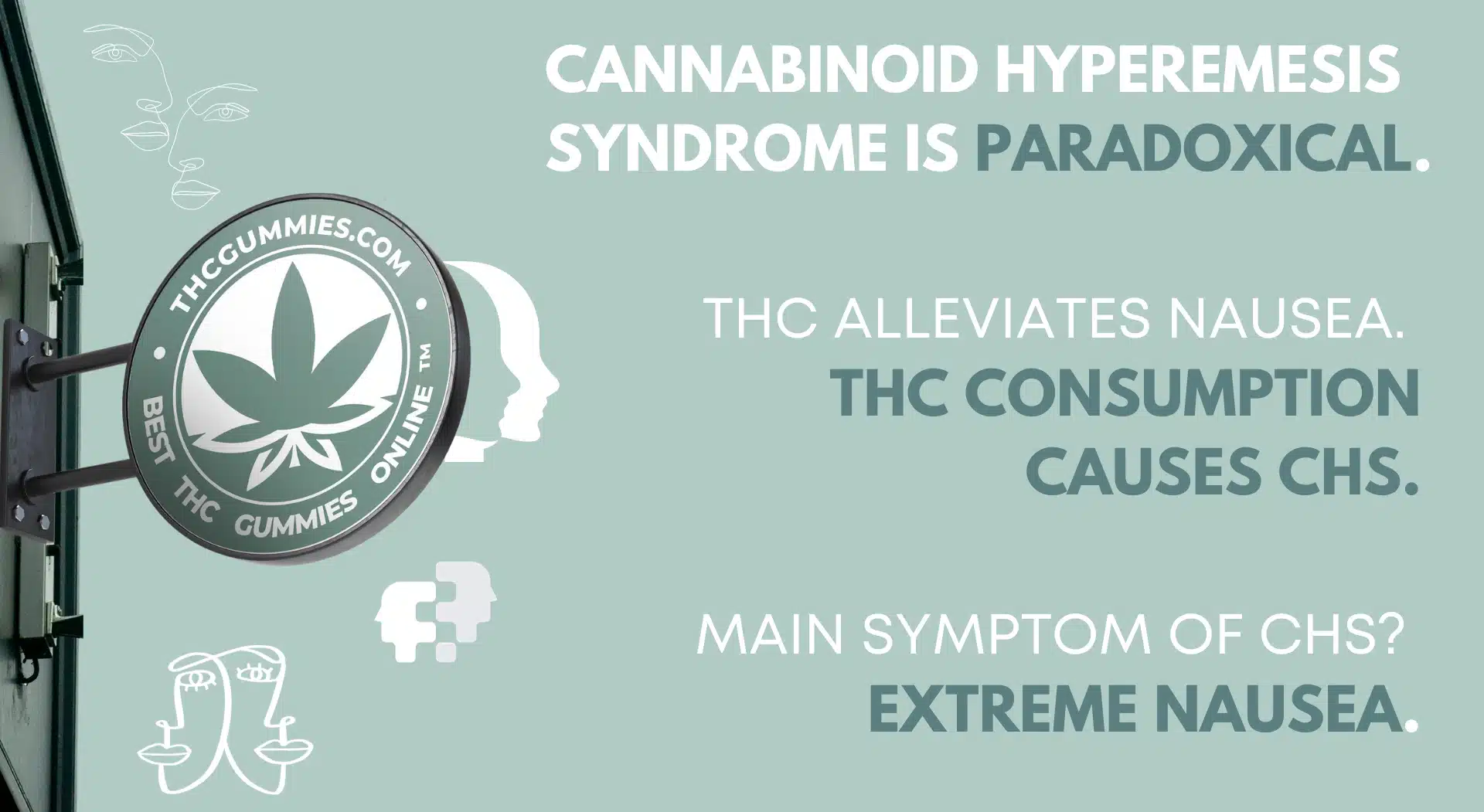
Marijuana & Nausea… it’s paradoxical.
SUMMARY:
THE CAUSE OF CANNABINOID HYPEREMESIS SYNDROME
Chronic marijuana use spanning several years causes a constant activation of the TRVP1 cannabinoid receptors. These receptors are found mostly in the gut and brain. This constant excitement causes the TRVP1 to become overstimulated and ultimately, deactivated. The deactivation of the TRVP1 cannabinoid receptor alters the signaling between the digestive tract and brain. This dysregulation of the gut-brain connection is believed to trigger the nausea, vomiting, and stomach pain, leading to the diagnosis of CHS.
Why some heavy, long-term marijuana users develop CHS while others don’t remain unclear; however, genetic factors are now presumed to play a role.
The question now is…
HOW MUCH MARIJUANA IS CONSIDERED CHRONIC/HEAVY USE?
QUOTES FROM DOCTOR’S ABOUT HOW MUCH WEED THEIR CHS PATIENTS WERE CONSUMING
Dr. James Hugh Allen, I call him the “Founder of CHS” (because he found it first), said that his initial patient with CHS was doing the following:
“Actually smoking quite industrial quantities.”
Later, and then serving 19 patients with CHS, he made the following observation:
“They were smoking up to 30 or 40 cones a day for some of them.”
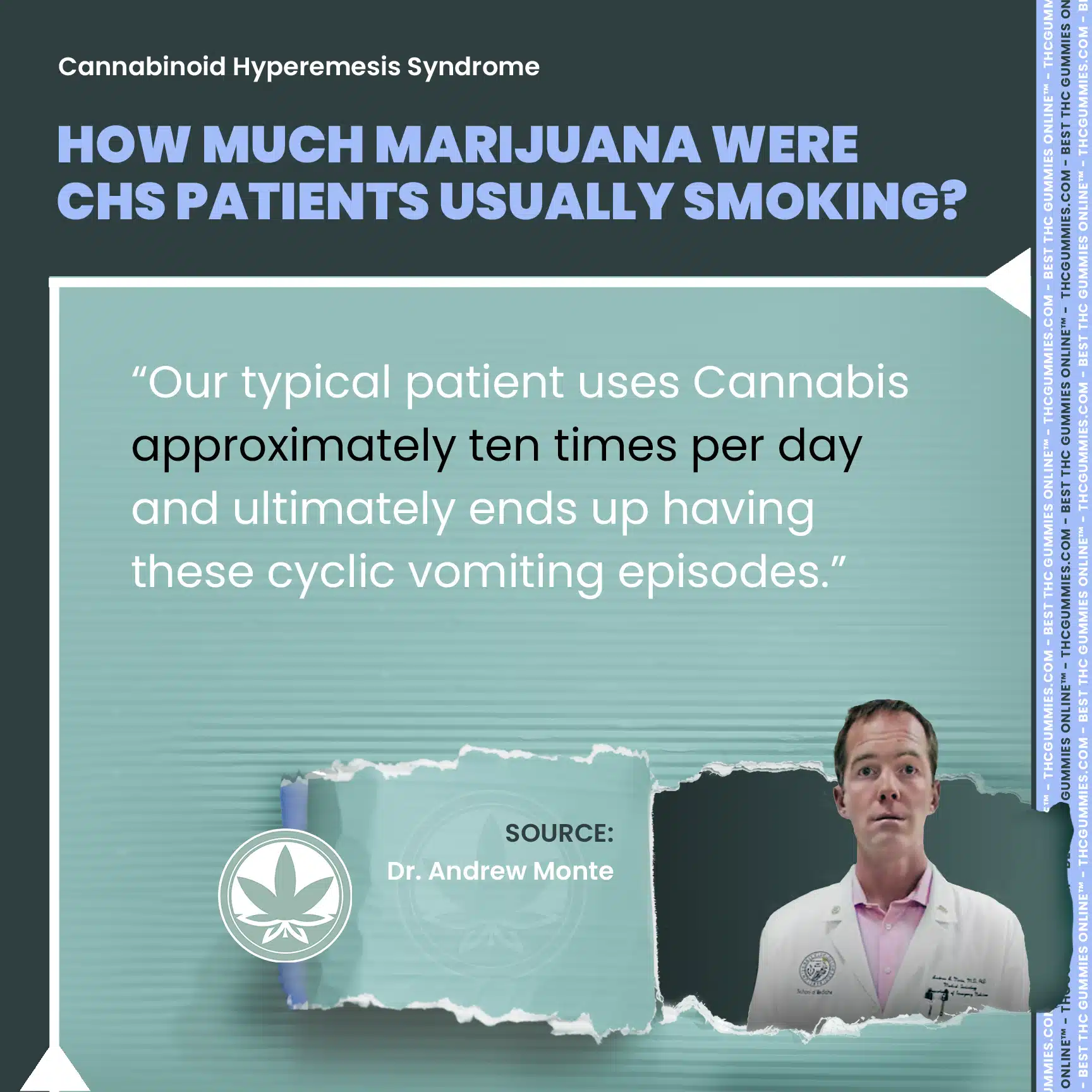
How Common Is CHS?
With great, new, and legal Hemp products, comes great responsibility. Some people forgot the latter. Directly, CHS is not that common, pretty rare, in fact. However, the growth in cases are certainly on the rise.
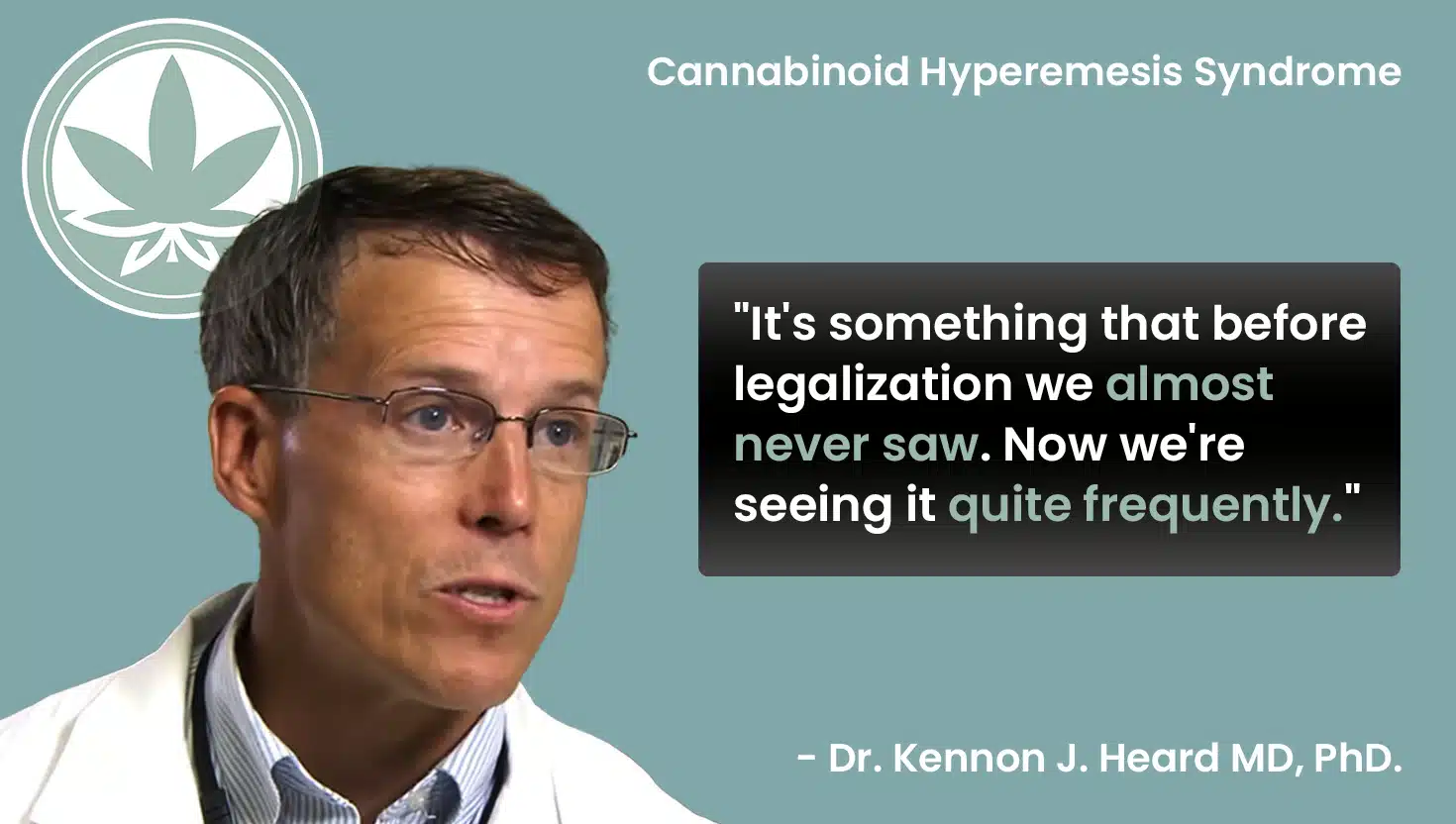
Did you know that 6% of people who went to an emergency room for vomiting had CHS, according to this 2021 study.
“A relatively new condition and only now it’s becoming more common and in numbers where we can study it in a population.”
Dr. Monte on CHS - A growing concern since 2019
Before taking the ‘it’s rare, there’s nothing to worry about,’ you may want to have the next topic in your knowledge bank.
The TWO Symptoms of CHS That Wreck Havoc On Your Body
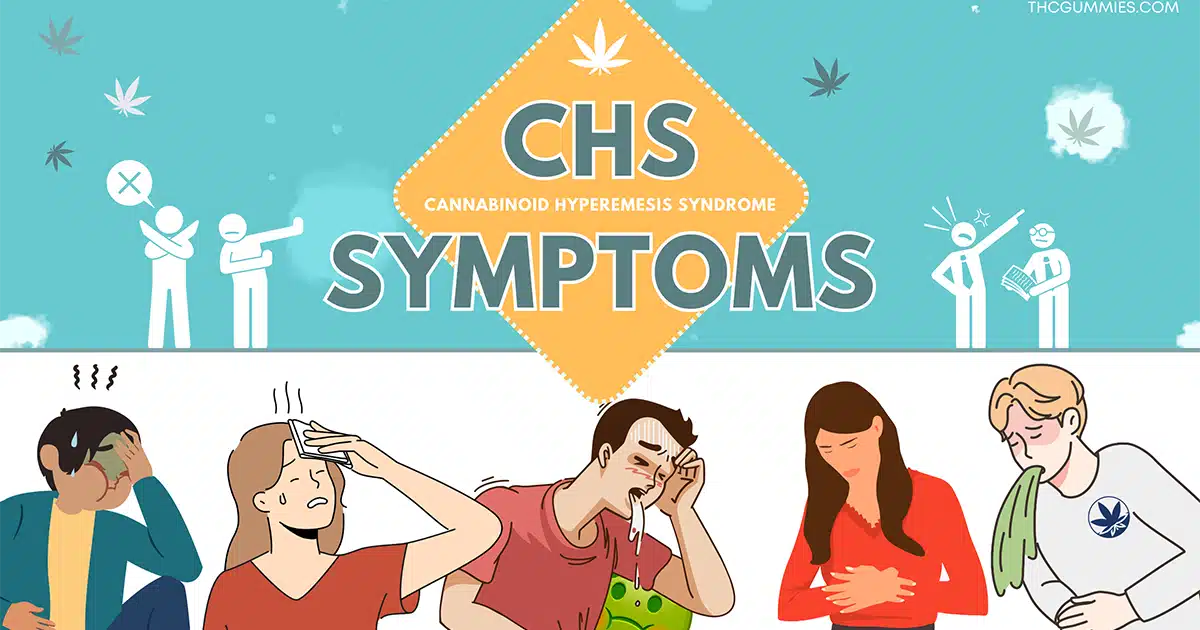
Here is a list of the main symptoms you could expect to experience if you get CHS:
- Severe nausea
- Excessive vomiting, often violent and uncontrollable
WHICH THEN CAUSE…
- Abdominal pain, usually diffuse rather than localized
- Compulsive hot bathing or showering for symptom relief
- Weight loss from persistent vomiting and nausea
- Dehydration
Not a good time.
Now, let’s talk about the 3 phases of CHS.
The Three Phases of CHS & The Symptoms For Each Phase
The early signs of CHS include:
- Morning nausea
- Abdominal pain in the mornings
- Frequent vomiting
- Fear of vomiting
During this phase, people often continue normal eating patterns and may increase marijuana use, thinking it will help curb the nausea. The prodromal phase can last for months or years.
Also known as the hyperemetic phase, the hyperemesis phase involves:
- Frequent, intense vomiting
- Ongoing nausea
- Abdominal pain
- Decreased food intake and weight loss
- Dehydration
People often take frequent hot showers for temporary relief during this phase, as heat seems to ease nausea. Medical care and assistance is usually considered during this phase due to the discomfort and confusion you feel.
When marijuana use stops entirely, the nausea and vomiting will resolve over days or weeks. Eating patterns return to normal during the recovery phase, which can last for days or months. However, symptoms often return if marijuana use resumes.
This study reported how 3 participants wanted to retest CHS symptoms by consuming cannabis again after getting better. I’m questioning these 3 participants intelligence level, but I regress.
Here’s what was found:
Three patients rechallenged themselves by resuming marijuana and relapsed within months. Two of these three abstained again and got better, while the third did not, and remains sick.
Dr J H Allen
What Are the Long-Term Effects of Cannabis Hyperemesis Syndrome?
Repeated bouts of vomiting and dehydration from CHS can lead to serious complications including:
- Severe dehydration requiring hospitalization
- Esophagitis (inflammation and damage to the esophagus)
- Tooth decay (from stomach acid brought to your mouth from excessive vomiting)
- Mallory-Weiss tears in the esophagus
- Electrolyte imbalances
- Nutritional deficiencies and malnutrition
Some studies also indicate there may be lasting effects on the gastrointestinal system even after cannabis cessation.
Diagnosing Cannabinoid Hyperemesis Syndrome
Since CHS is a newly recognized condition, some doctors may not consider it initially.
A gastroenterologist may be most likely to recognize CHS.
To diagnose CHS, doctors rule out other potential causes of severe vomiting through:
- Physical exam
- Blood tests
- Urine tests
- Imaging tests like x-rays or CT scans
- Endoscopy
There is no definitive test for CHS.
The diagnosis is made clinically based on the typical symptoms present in a long-term marijuana user, exclusion of other causes, and resolution of symptoms after stopping marijuana use.
When to Go to the Emergency Room for CHS
This was casually touched on when explaining the 3 Phases of CHS. Due the symptoms of CHS that are experienced during the hyperemetic phase, this is the point and time that people should and would likely take the trip to the nearest emergency department (ED), emergency room, or closest hospital for treatment.
Seek emergency care if you experience any signs of severe dehydration, including:
- Rapid heartbeat
- Lightheadedness or fainting
- Confusion
- Dark urine or decreased urination
- Dry mouth and skin
IMPORTANT NOTE:
Don’t fee bad, nervous, embarrassed, or egotistical when being asked questions by medical professionals. It’s crucial to be honest about CHS and your cannabis use history; it’s the only way you can be confident that you’ll receive appropriate treatment that’s tailored to your unique situation.
How CHS Is Treated: A General Overview of Treatment Options & THERAPEUTIC REMEDIES
Therapeutic and symptomatic relief options for CHS involves any or all of the following:
- Various Medications (listed below)
- Intravenous (IV) fluid replacement for dehydration
- Hot Water Showers & Baths
With that shared, according to the latest research, CHS resists standard anti-vomiting medications.
While that doesn’t sound comforting, there are many case reports that show some benefit from the following types of medications:
- benzodiazepines
- tricyclic antidepressants
- anti-seizure medications
- antipsychotics
- capsaicin cream
Lets get in to the #1 mentioned therapeutic remedy.
Hot Water Hydrotherapy (Hot Showers)
The most-mentioned therapeutic treatment in all research, including reports from CHS patients was taking hot showers; the medical community calls this “hot water hydrotherapy.”
Why would hot showers help with nausea and vomiting?
I’m super glad you asked.
How Does Taking Hot Showers Help CHS?
How water hydrotherapy only relieves CHS symptoms temporarily, but it’s effective. I found a study from 2018 and the title really grabbed my attention, “Successful Treatment of Cannabinoid Hyperemesis Syndrome with Topical Capsaicin.” The explanation in the study was too difficult to understand, so I had to reach out to my friend and business partner, Dr. Bryan Doner, MD, DO, CHWS, FAPWCA, to fully comprehend it and share with you.
You can see both explanation examples below (medical and Layman’s terms).
THE MEDICAL EXPLANATION
Proposed pathophysiology of cannabinoid hyperemesis syndrome.
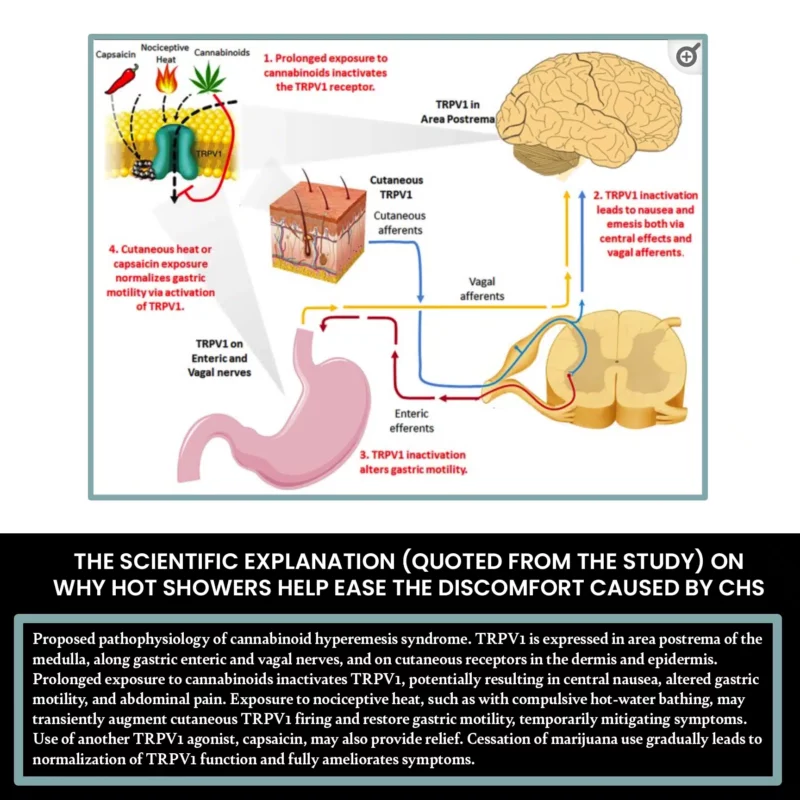
In Layman's Terms
The reason why hot showers help alleviate the symptoms of CHS.
Imagine there's a special kind of switch in your body called TRPV1. This switch plays a big role in how you feel pain, control your stomach movements, and how you feel nausea.
Now, the use of marijuana over long periods of time causes this switch to get turned off; leading people to feel nauseated, have stomach pain, and changes in how food moves through your stomach.
Here's where it gets interesting!
If you expose your skin to something really hot, like taking a very hot bath, it can temporarily turn this switch back on. When the switch is on, your stomach starts moving food properly again, and you feel less sick. Another way to flip this switch back on is by using something called capsaicin, which is what makes chili peppers spicy.
The best way to fix this problem, though, is to stop using cannabis. When someone stops using it, the TRPV1 switch starts working normally again over time, and all those uncomfortable symptoms go away.
Quick Tip: If you’re on your own, please remember that when we vomit a lot, we discharge a lot of water from our bodies. So, remember to limit hot shower time to avoid further dehydration.
Other treatments may include:
- Antiemetic medications (Anti-nausea/vomiting)
- Pain relief medications
- Proton-pump inhibitors to reduce stomach inflammation
- Capsaicin cream on the abdomen for pain relief
Concluding Statements On CHS Treatment Options
- Medications and Hot Water Hydrotherapy only offer temporary relief.
- The only cure for CHS is to permanently stop using marijuana.
As mentioned earlier, medications won’t treat this condition, and stopping cannabis use is the only definitive treatment.
If you think you may have CHS, just know that with marijuana cessation, symptoms improve within days to weeks. Consider reaching out to your doctor, outpatient counseling, or drug rehab programs to ensure that you completely refrain from cannabis substance abuse.
Why?
Because relapse is extremely common, and if you begin consuming marijuana again, which most people try and do, your episodes of vomiting will resume (according to previous cases and research).
How To Prevent Cannabinoid Hyperemesis Syndrome
For starters, don’t smoke 30-40 spliffs a day.
The CHS Bullet-Proof Prevention Tip:
I hope you’re sitting down. NEVER SMOKE OR CONSUME MARIJUANA AGAIN.
It sucks to share that with you, but it’s the only way you can 100% guarantee you’ll never get CHS.
While that is the best tip, there are more options you can consider to greatly reduce the risk of being diagnosed with CHS.
T-BREAKS: A MORE REALISTIC APPROACH TO PREVENTING CHS
If you love cannabis like I do, I’m sad to say, we must learn to take breaks; we call it the “T-Break” (THC Break).
If you smoke, eat THC gummies, or vape THC everyday, my professional (not medical) recommendation is to adopt the following T-Break plan at the bare minimum:
- Abstain from THC at least one day (24-hours) per week.
- Every 3 months (every quarter of the year), take a 48-72-hour THC break. Why 2-3 days?
The reason to take a 2-3-day break from THC was not pulled out of my rear.
Here’s the Scientific juice…
According to this 2022 study, CBRs (cannabinoid receptors) levels get reduced from chronic THC use.
The study then outlined that once the participants took a 48-hour T- break, their bodies showed a massive increase in the production of CB1 receptors. AKA, their bodies successful attempt, more specifically, their Endocannabinoid Systems attempt, to get them back into homeostasis.
For heavy, long-term users who don’t want to fully quit, here are few things you should consider avoiding:
- Daily use and consumption (in everything we do in life, there should be a break involved)
- High potency THC concentrates (includes THC wax, dabs, shatter, crumble, budder, etc)
- Synthetic cannabinoids (not enough data to determine safety, with some data showing more adverse affects)
I bet #2 made a few people mad.
TIPS & INFO FROM DR. ETHAN RUSSO
‘The Cannabis Conversation Podcast’ aired an episode titled “Cannabinoid Hyperemesis Syndrome with Dr. Ethan Russo.”
At 08:54 in this episode, Dr. Russo said something that I found IMPERATIVE TO SHARE with you. Take a listen (transcript below the video incase volume is not allowed). For the Destiny’s Child fans, Dr. Ethan also says the word, “bugaboo.”
“It’s (CHS) becoming more common. And the reason is, the availability of higher THC potency material in most areas. This is something people need to know about. Both the medical community as well as consumers.”
If you don’t know Dr. Ethan Russo, you should! He does great work for the Cannabis industry. He says to:
Consider avoiding:
- Anything over 25% ∆9-THC is rare.
- Anything over 35% ∆9-THC is not ‘consuming responsibly.’
Mother Nature never intended you to have that much Tetrahydrocannabinol per dose.
I’m Putting This Information Here On The Chance That Someone Needs It
Seeking addiction counseling can help if you’re struggling to cut back or quit cannabis. Your healthcare provider can connect you with counseling and other support services.
Conclusion
Cannabis hyperemesis syndrome is a debilitating condition affecting some chronic cannabis users. Although rare, its prevalence is increasing with rising marijuana use.
CHS leads to severe, cyclical nausea and vomiting, disrupting quality of life. Put simply, avoid getting CHS at all costs, or else you may have to quit cannabis, forever.
Once you develop CHS, and regardless of how many T-breaks you conduct after diagnosis, CHS episodes (nausea/vomiting) can reoccur anytime cannabis is used again…
I wouldn’t wish that on my worst enemy.
ONE LOVE, EVERYONE!
References
- Allen, J. H., de Moore, G. M., Heddle, R., & Twartz, J. C. (2004). Cannabinoid hyperemesis: cyclical hyperemesis in association with chronic cannabis abuse. Gut, 53(11), 1566–1570.
- National Institute of Diabetes and Digestive and Kidney Diseases. (n.d.) Cyclic Vomiting Syndrome.
- Sorensen, C. J., DeSanto, K., Borgelt, L., Phillips, K. T., & Monte, A. A. (2017). Cannabinoid hyperemesis syndrome: Diagnosis, pathophysiology, and treatment—a systematic review. Journal of Medical Toxicology, 13(1), 71–87.
- Kim, H. S., Anderson, J. D., Saghafi, O., Heard, K. J., & Monte, A. A. (2015). Cyclic vomiting presentations following marijuana liberalization in Colorado. Academic Emergency Medicine, 22(6), 694–699.
- Habboushe, J., Rubin, A., Liu, H., & Hoffman, R. S. (2018). The prevalence of cannabinoid hyperemesis syndrome among regular marijuana smokers in an urban public hospital. Basic & Clinical Pharmacology & Toxicology, 122(6), 660–662.
- Galli, J. A., Sawaya, R. A., & Friedenberg, F. K. (2011). Cannabinoid hyperemesis syndrome. Current Drug Abuse Reviews, 4(4), 241–249.
- Chu, F., & Cascella, M. (2022). Cannabinoid Hyperemesis Syndrome. In StatPearls. StatPearls Publishing.
- Venkatesan, T., Levinthal, D. J., Li, B., Tarbell, S. E., Adams, K. A., Issenman, R. M., Sarosiek, I., Jaradeh, S. S., Sharaf, R. N., Sultan, S., Stave, C. D., Monte, A. A., & Hasler, W. L. (2019). Role of chronic cannabis use: Cyclic vomiting syndrome vs cannabinoid hyperemesis syndrome. Neurogastroenterology and Motility, 31 Suppl 2(Suppl 2), e13606.
- Blumentrath, C. G., Dohrmann, B., & Ewald, N. (2017). Cannabinoid hyperemesis and the cyclic vomiting syndrome in adults: recognition, diagnosis, acute and long-term treatment. German Medical Science: GMS e-journal, 15, Doc06.
- Moon, A. M., Buckley, S. A., & Mark, N. M. (2018). Successful Treatment of Cannabinoid Hyperemesis Syndrome with Topical Capsaicin. ACG case reports journal, 5, e3.
- Pergolizzi, J. V., Jr, LeQuang, J. A., & Bisney, J. F. (2018). Cannabinoid Hyperemesis. Medical cannabis and cannabinoids, 1(2), 73–95.
- Bhatt, S., Queen, J. (2019). Cannabinoid Hyperemesis Syndrome. Curr Emerg Hosp Med Rep7, 14–18

If this article sparked a new insight, pass the flame…
LET’S IGNITE RIPPLES OF CANNABIS WISDOM.
Be the catalyst for someone’s breakthrough moment.
SHARE ON SOCIAL MEDIA

YOUR CANNABIS EDIBLE
JOURNEY CONTINUES:
Looking For Something Else?


